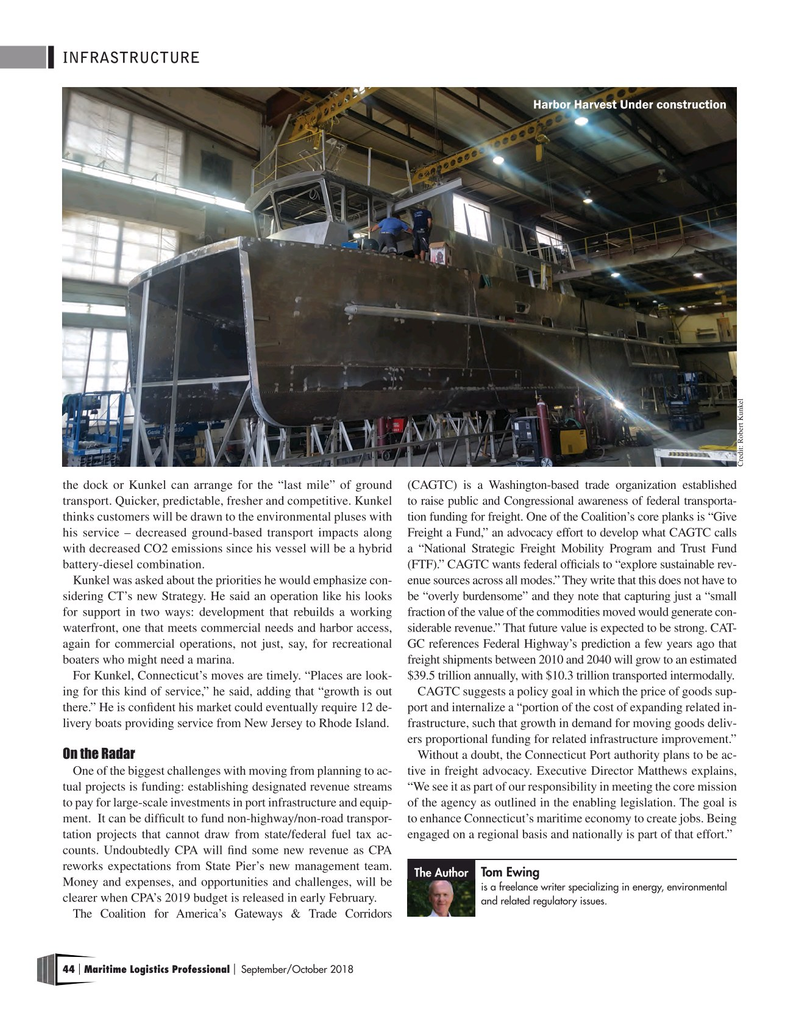
Page 44: of Maritime Logistics Professional Magazine (Sep/Oct 2018)
Liner Shipping & Logistics
Read this page in Pdf, Flash or Html5 edition of Sep/Oct 2018 Maritime Logistics Professional Magazine
INFRASTRUCTURE
Harbor Harvest Under construction
Credit: Robert Kunkel the dock or Kunkel can arrange for the “last mile” of ground (CAGTC) is a Washington-based trade organization established transport. Quicker, predictable, fresher and competitive. Kunkel to raise public and Congressional awareness of federal transporta- thinks customers will be drawn to the environmental pluses with tion funding for freight. One of the Coalition’s core planks is “Give his service – decreased ground-based transport impacts along Freight a Fund,” an advocacy effort to develop what CAGTC calls with decreased CO2 emissions since his vessel will be a hybrid a “National Strategic Freight Mobility Program and Trust Fund battery-diesel combination. (FTF).” CAGTC wants federal offcials to “explore sustainable rev-
Kunkel was asked about the priorities he would emphasize con- enue sources across all modes.” They write that this does not have to sidering CT’s new Strategy. He said an operation like his looks be “overly burdensome” and they note that capturing just a “small for support in two ways: development that rebuilds a working fraction of the value of the commodities moved would generate con- waterfront, one that meets commercial needs and harbor access, siderable revenue.” That future value is expected to be strong. CAT- again for commercial operations, not just, say, for recreational GC references Federal Highway’s prediction a few years ago that boaters who might need a marina. freight shipments between 2010 and 2040 will grow to an estimated
For Kunkel, Connecticut’s moves are timely. “Places are look- $39.5 trillion annually, with $10.3 trillion transported intermodally.
ing for this kind of service,” he said, adding that “growth is out CAGTC suggests a policy goal in which the price of goods sup- there.” He is confdent his market could eventually require 12 de- port and internalize a “portion of the cost of expanding related in- livery boats providing service from New Jersey to Rhode Island. frastructure, such that growth in demand for moving goods deliv- ers proportional funding for related infrastructure improvement.”
On the Radar
Without a doubt, the Connecticut Port authority plans to be ac-
One of the biggest challenges with moving from planning to ac- tive in freight advocacy. Executive Director Matthews explains, tual projects is funding: establishing designated revenue streams “We see it as part of our responsibility in meeting the core mission to pay for large-scale investments in port infrastructure and equip- of the agency as outlined in the enabling legislation. The goal is ment. It can be diffcult to fund non-highway/non-road transpor- to enhance Connecticut’s maritime economy to create jobs. Being tation projects that cannot draw from state/federal fuel tax ac- engaged on a regional basis and nationally is part of that effort.” counts. Undoubtedly CPA will fnd some new revenue as CPA reworks expectations from State Pier’s new management team.
Tom Ewing
The Author
Money and expenses, and opportunities and challenges, will be is a freelance writer specializing in energy, environmental clearer when CPA’s 2019 budget is released in early February.
and related regulatory issues.
The Coalition for America’s Gateways & Trade Corridors 44 Maritime Logistics Professional September/October 2018 | |

 43
43

 45
45
